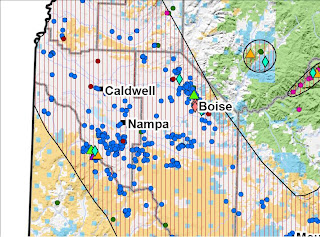Week 2 Peaceful Belly Produce Pick-Up
Turnip & Turnip Greens:
For bigger turnip, gently wash, peel and cube before adding to the skillet to sauté – add sliced carrots, freshly minced ginger, a healthy portion of fresh garlic and a handful of fresh cilantro to the mix – drizzle a small amount of olive oil (or butter), cover and allow to cook through (until vegetables are crisp tender)… The tantalizing aroma is sure to bring the family to the table!
Now for the Turnip Greens. Remove the large stems from the center of the greens; soak in a medium size bowl of water to dislodge any residual dirt and cook as you would any other leafy green.
Radish & Radish Greens: (Our recent variety looks to be an Easter Egg Radish)
To begin remove the greens from the radish as well as the spindly root and wash. While the radish is usually eaten raw I found several mouth-watering recipes online and this one seemed most appealing:
Recipe: (see http://giniann.wordpress.com/2006/12/23/radish-curry-saute-with-onions-garlic-and-chili/ for more recipes like this…)
Ingredients
A bunch of red radish - contains 6 to 8 radishes.
Onion- one small, sliced.
Garlic- 2 or 3 small cloves crushed
Green chilies - 8 small, crushed
Turmeric powder- a pinch.
Oil for sauté
Mustard seeds - a pinch
Curry leaves- a sprig
Salt to taste
The leaves: Roll all the leaves together and slice into long shreds.
Method:
1. Clean the radishes and cut them as you would slice an apple. Clean the leaves, if you want to use them in the dish.
2. In a pan, add some oil. When it is hot, add the mustard seeds.
3. When the mustard seeds splutter, add curry leaves and onions. Sauté for 3-5 mins till edges of the onions turn slightly brown.
4. Add the crushed garlic and chilis, and turmeric powder. Saute for about a minute or even less.
5. Add the radishes, mix well and add salt. Cook covered for about 3-4 mins.
6. Once the radish seems soft, remove the lid and crank up the heat. Saute on high heat for a couple more minutes. The radishes will be soft yet crunchy.
7. After you remove the radishes onto a plate, in the same pan quickly saute the leaves for a few seconds and add it to the top of the radishes.
8. For best results, serve right off the stove. The dish takes less than 15mins. Make this right before your meal.
When harvested young, radishes offer a nice crispy, tender flesh and mild taste.
Remember to use the Radish Greens. They are known to have a slight peppery flavor to them and can overpower the dinner plate if not use sparingly… however they can be cooked just as any other leafy green – or eaten raw.
Spinach:
Popeye sings: I’m strong to the finish, ’cause I eats me spinach… I’m Popeye the Sailor Man… What more do I need to say?
To preserve your precious produce, simply wrap the kale in a damp paper towel and pack in a plastic bag – it should stay fresh in the refrigerator for several days however many leafy greens such as kale will quickly wilt (it still tastes great and offers tremendously healthy nutrients.)
Whether you choose to sauté your bunch of kale or eat it steamed with cranberries and lightly toasted pine nuts, kale is a great source of nutrients. Packed with healthy amounts of fiber, beta-carotene, calcium, iron, folic acid as well as Vitamin C, ounce for ounce you are giving your body the recharge that it needs to stay in tip-top form!
Cilantro:
This herb has a tendency of wilting and loosing its robust flavor if left unused for too long. Wrap it in a damp paper towel and place in a plastic bag before storing it in the crisper drawer of the refrigerator for a few days.
Native to the Mediterranean region, this herb is found in most Mediterranean – Mexican – Spanish meals… The funny thing about this herb is its name or rather, what it is called when harvesting the fresh leaves versus harvesting its seed. Fresh Leaves: Cilantro – Seeds: Coriander.
Red Mustard:
A taste of horseradish is found in this fine leafy green. The peppery flavor is tamed by prolonged time on the stove – if you want “fire” then braise for a matter of minutes – if you are looking for a mild “flame” then let it stand a little longer.
I was told that this particular green really brings out the flavor of Seared Ahi Tuna by a reputable source and time permitting will report back with my experience…






